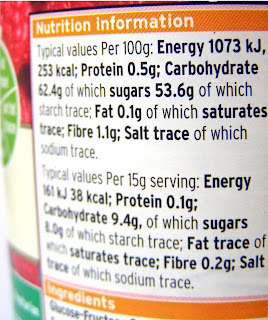Now,
for some of the more generic terms:
Serving Size.
This
is the amount of a particular food that the nutrition information is
referencing. The
USDA sets these numbers, but they can be very misleading if you don't
read the labels carefully. While
they have gotten better in terms of showing both the English and
Metric measurements, the sizes are still smaller than what you might
normally eat. Even
small containers might only have a 'partial' listing. For
instance, the serving size referenced on
a 'standard-sized' can
of Dr. Pepper is 100 calories per 8-ounce serving. I don't know about
you, but I don't make it a habit to only consume two-thirds of a
12-oz can of soda. The actual amount of calories I take
in
when I drink a can of Dr. Pepper is actually 150 but, if I hadn't
read the label carefully, I wouldn't have seen that. Food
manufacturers know this, and know it well.
Cholesterol/Sugar/Fat free.
Contrary to what most of us think of when we see 'free', these foods
do have some of the 'referenced ingredient' in them. It's just that
the levels are so low as to be seen as insignificant. For
instance, for a food to be labeled 'cholesterol-free', it can have no
more that 2 milligrams of cholesterol and 2 grams of saturated fat
per serving. For sugar, it's less than half a gram per serving, with
the same amount applying to fat.
Low Cholesterol/Sodium/Fat.
The product must have less than 20 milligrams of cholesterol, 140
milligrams of sodium or 3 grams of fat to claim to be 'Low
[whatever]'.
'Reduced'.
This usually means that the amount of whatever ingredient is being
referenced is at least 25% less than what the food would have been
otherwise.
Lean.
Usually less than 10 grams of fat, although a lot of meat products
will specify the exact amount of fat on the label.
Light.
Exactly what this means depends on the food. If the 'regular
version' of a food gets 50% or more of its calories from fat, the
'light' version must have less than half the fat. If the 'regular
version' gets less than 50% of the calories from fat, 'light' means
that it has been altered so that it contains either less than half
the fat or one-third fewer calories.
High in/Excellent source of [x].
This means that a serving contains more
than 20% of the recommended daily allowance for whatever nutrient
it's referencing. A 'good' source has between 10 and 19%.
Fortified/Enriched/etc.
Both labels mean that extra nutrients have been added to a food, but
the 'reasons' may be different. “Enriching'
is replacing nutrients lost during processing while 'fortifying' is
adding nutrients that weren't originally there to make it 'better'.
Either way, you win.
Whole-Grain. This is
pretty much self-explanatory; the grains used in a particular food
have not been 'stripped' and still have the germ, endosperm and bran
that occurs naturally. An example would be brown rice as opposed to
white rice. For more information, visit
http://wholegrainscouncil.org/whole-grains-101/definition-of-whole-grains
Hopefully I've been able to de-code
some of the terms commonly used to describe what's in the foods we
eat. Remember-read the labels!
For more information, visit
http://www.cancer.org/healthy/eathealthygetactive/takecontrolofyourweight/understanding-food-labels


No comments:
Post a Comment